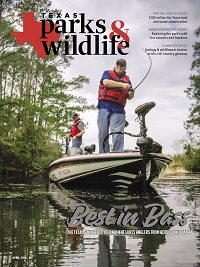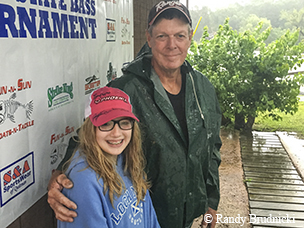
Angler vs. Fish
The Texas State Bass Tournament keeps the spirit of competition alive.
By Randy Brudnicki
In 1955, Earl Golding, outdoors editor for the Waco Tribune-Herald, invited fellow writers and various characters and cohorts to what turned out to be a well-attended bass fishing challenge. It was likely the very first Texas bass tournament of this type and magnitude.
Word spread quickly. So many people contacted Golding wanting to join in that he changed the format to an open bass fishing tournament. Could this epic event be the longest continuously held bass tournament in Texas? Likely.
What makes an event “epic” worthy? Perhaps it’s a combination of elements such as a storied history, unpredictable weather, venue vagaries and a high level of fierce competition.
The Texas State Bass Tournament embodies all of that and more. Part competition, part family gathering and part angler fellowship, the Texas State Bass Tournament has kept the man vs. fish vs. man challenge alive for 63 years.
“It is a rewarding weekend, low cost and very competitive,” says tournament director Sam Scroggins. “It’s fun for the family.”

Volunteers help keep the tournament on track.
Fishing is — by its nature — competitive, and bass anglers are particularly passionate. As early as the 1930s, a group of Washington state bass anglers began to meet at noon Saturdays, contribute to a pot of money and fish for 24 hours. The lucky guy who caught the biggest fish took all the money home on Sunday. These may have been the earliest bass tournaments.
At the Texas State Bass Tournament, anglers vie for bragging rights and trophies — no prize money here. (The winning high school two-person team takes home scholarships, though.)
The tournament divisions include adult/boy, adult/girl, senior team, high school team, adult team and individual. Anglers from age 8 to 80 compete.
Bring on the Epic Weather
The first day of competition last April on Toledo Bend Reservoir, where the tournament’s been held for the last five years and 31 times overall, started out in what many consider ideal bass-catching conditions: calm water with cloudy, overcast skies and aggressive, biting fish. By mid-morning, the weather turned bad. Extreme winds made boating dangerous, and a torrential rain slashed down sideways, making it nearly impossible to stay dry. The temperature dropped dramatically as well, adding to the challenge.

A granddaughter and grandfather win their division.
“We got off the water by 11 a.m. on day one because of the storms,” says Kenney Sherrell, who won the adult/boy division with his son, Weldon. The pair threw buzzbaits and other top-water baits. “We had a limit by 7 a.m. that weighed 14.1 pounds. After the rain let up a little we went back out but didn’t catch any more.”
Eleven-year-old Skylar Iversen didn’t let being drenched by the storm faze her at all, as she and her grandfather, Mike Knight, took first place in the adult/girl division. Knight has participated a dozen times with his boys, but this was the first time with his granddaughter.
“We caught about 14 total fish on Saturday; eight were keepers,” he says. “We caught some solid fish, but did not get a kicker. We caught the fish on spinner baits, frogs and Senkos.”
In tournament-speak, a “kicker” is a fish larger than the others in the bag limit. For example, four fish might weigh 2 to 3 pounds each, and a kicker could weigh 5 pounds or more. In most bass tournaments, it takes a kicker or two to propel you up the leaderboard.

Anglers on the water.
High school teams fish for just one day, so their awards start after their weigh-in on Saturday afternoon. Braden Clifton and Holden Lott finished first among high school teams and placed third overall in team competition. These young guns caught fish by using top-water lures and by punching hay grass mats. Their 5.43-pound “kicker” made the difference in the win over the second-place high school team.
Their kicker fish was caught on a Strike King Rage Tail Space Monkey bait from a tackle pack of free baits from event sponsors. This bait can be very effective, but the technique used is what sets it apart: “punching.”
Punching is a technique used to penetrate thick clumps of aquatic vegetation that form a nearly impenetrable mat or a dense canopy of green or dead plants above the fish. Normal presentations of lures will not pierce through the mat to where the bass can be found. Anglers put a heavy weight (1 to 4 ounces) on their line above and pegged against a hook rigged with a compact plastic bait. The weight is thrown hard onto the matted vegetation, so it penetrates or “punches” through. Anglers let it fall until it makes contact with the lake bottom under the canopy, a very effective tactic at times.
Sorting out the Terms
Bass anglers have a vocabulary of strange names for their lures.
The high school team fished “top-water” — using lures that float on the surface. Usually when bass are hitting on top, a variety of sizes, styles and brands can be effective.

Tournament contestants receive a tackle pack from sponsors.
A spinner bait is a wire-framed lure shaped much like a safety pin. It has a blade on the top wire and a hook on the bottom wire.
A frog is a hollow plastic lure, which may or may not resemble the shape of a frog. It floats on the surface, and the hooks are close to the body, so the lure comes through vegetation such as matted weeds without snagging up. When a bass bites down, the plastic collapses, exposing the hooks to catch in the bass’s mouth.
A Senko is the most nondescript plastic bait you may ever see. Liquid plastisol is injected into a mold that’s shaped almost like a Bic pen, which the inventor claims was his source of inspiration for the design. It does catch fish.
Sunday Brings Sunshine
Saturday’s storm front was the first time in 20 years that weather played such a pivotal role in the competition. Sunday brought calmer, sunnier and warmer conditions, as late April’s changeable weather can often do.
For all divisions except high school, it’s a two-day tournament. Friday night before the next day’s competition, anglers register at the Fin & Feather Resort pavilion, where participants get tackle packs and their boat number, used to identify themselves when checking in for the weigh-in on tournament days.
The anglers are allowed to begin fishing at 6 a.m. both days. Some participants navigate to their fishing spot in the dark so they are ready to make the first cast on their preferred spot at that precise moment. There’s a staggered weigh-in time (with mandatory punctual check-in) based on division.

Bass are released from a holding tank back into the lake.
All fish are kept alive in a livewell in the boat and transferred to a large plastic bag full of water to take to the weighing area. After the fish are weighed, they’re released back into the lake.
“I’ve been fishing all my life and this lake [Toledo Bend] since a year after it opened,” says sixth-place team finisher and 50-year participant Leonard Watson of Fort Worth, who’s competed with his son, now 52, for 12 years. “I do it because I like the competitive feel of it — because I’m a competitive person.”
The Sunday awards ceremony first honors anglers in the Texas State Bass Tournament Hall of Fame (introduced in 1998), new inductees and anglers who passed away, then hands out the winners’ plaques and trophies. The adult/boy, adult/girl, individual and senior divisions award five places, and the highly competitive team and couples divisions award 15-20 places, so there are lots of winners.
In recognition of its honored place in Texas fishing, the Texas State Bass Tournament was inducted into the Texas Freshwater Fishing Hall of Fame in 2016. Find out more about the tournament at texasstatebass.com.
Related stories

